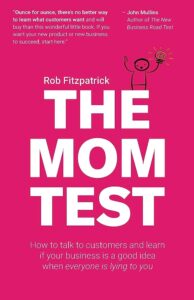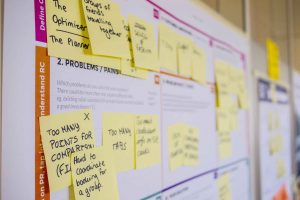How To Build and Pivot a Minimum Viable Product For Your SaaS Business
Most SaaS businesses begin with a promising idea which is set to revolutionize how the world operates. However, passionate founders often invest substantial time and energy in creating a refined product, only to realize it addresses a problem that lacks interest.
The issue stems from fundamental assumptions: assuming the SaaS product effectively solves a problem, that the problem is significant enough for people to pay for a solution, and that it outperforms competitors.
As a startup founder, the primary focus should not be on building the best product or scaling quickly; instead, it’s about proving or disproving these assumptions in the most cost-effective way. This is where the Minimum Viable Product becomes crucial.
In this guide, I’m going to show you exactly how to build an MVP that succeeds and kickstarts your business.
If you’re more of a watcher than a reader, check out this great 2-minute guide to creating an MVP.
What Is an MVP?
A Minimum Viable Product (MVP) is a version of a new product that includes only the essential features necessary to meet the needs of early adopters and gather feedback for further development.
The primary goal of an MVP is to quickly bring a functional and scaled-down version of the product to market, allowing the development team to test its viability and receive user input. By focusing on core functionalities, an MVP accelerates the product development cycle, reduces time to market, and minimizes resource investment.
What Are the Main Benefits of an MVP?
In my experience, there are 5 main benefits to creating a Minimum Viable Product instead of making a full-blown SaaS app:
- Swift Market Entry: Developing an MVP allows for a quicker entry into the market by releasing a basic version promptly, enabling early interaction with potential users.
- Real User Feedback: MVPs facilitate the gathering of valuable feedback from actual users, providing insights into how users interact with the product and helping refine it based on their preferences.
- Cost Efficiency: By focusing on essential features and avoiding unnecessary complexities, MVPs minimize development costs, making them a cost-effective approach for startups with limited resources.
- Learning Market Preferences: Creating an MVP helps in understanding what resonates with the target audience, allowing for adaptations based on user preferences and increasing the product’s market fit.
- Iterative Improvement: The iterative nature of MVP development allows for continuous enhancements. Early adopters may tolerate an incomplete product, and their feedback can be used to refine and add features in subsequent iterations.
The 4 Types of MVP
Developing a SaaS solution comes with inherent risks. Crafting a flawless, refined product often demands countless hours of development, and there’s no assurance that people will embrace it, let alone pay for it. Therefore, I’ll explore four strategies that can help you build a Minimum Viable Product (MVP) to reduce development time and enhance the likelihood of creating a solution that fulfils genuine user needs.
Landing Page MVP

When preparing to sell your final product, it’s beneficial to create a landing page or two. Why not construct a landing page even before you have a fully finished product? Develop a captivating landing page that highlights the benefits of your upcoming product and generates anticipation. Alongside that, establish an AdWords campaign to drive traffic to the landing page. This approach, employed by author Tim Ferris to test potential book topics, involves creating ads for each topic and monitoring audience responses.
Measure conversion rates by inviting people to sign up for more information or even simulate a purchase of your product, only to present them with an “out-of-stock” or “available soon” message. While this approach may raise ethical concerns, it serves as an effective means of gauging the desirability of your product. However, it’s important to note that a simple email sign-up form alone does not constitute a Minimum Viable Product (MVP). Merely capturing email addresses does not provide validated learning.
To transform your landing page into a true MVP, as outlined by Joel Gascoigne from Buffer, it’s crucial to leverage it as a platform for gathering extensive product feedback. Encourage visitors to click a sign-up button before providing their email address. Furthermore, request that they click a pricing plans button, choose a plan, and then provide their email address. This way, you can obtain valuable validated learning. Follow up with conversations to delve deeper into why they shared their email address and ascertain whether they genuinely face the problem your product aims to solve.
You can learn how to create an excellent and well-converting landing page here.
Explainer Video MVP
Once upon a time, Dropbox, the renowned cloud storage giant, resembled nothing more than a captivating YouTube video. In this three-minute explainer video, founder Drew Houston delved into the fundamental principles of the Dropbox solution, cleverly incorporating geeky in-jokes to resonate with his target audience of early adopters. Surprisingly, this video alone generated a remarkable surge of interest and effectively validated the concept behind Dropbox.
In the case of Dropbox, Drew had already developed a basic prototype, but it’s worth noting that you don’t necessarily have to go that far. As long as your explainer video accurately portrays the intended functionality of your product, you can still gather valuable insights about the perceived value of your idea.
If you’re interested, you can watch the Dropbox MVP below.
Flintstone MVP
Imagine if you witnessed the Flintstone family driving by in their iconic “car.” At first glance, you might assume it’s powered by an engine. However, beneath the surface, their vehicle actually relies on old-fashioned manpower. This concept forms the foundation of the Flintstone MVP, also known as the Wizard of Oz MVP. It involves creating the illusion of a fully functional product while, in reality, relying on manpower alone (and services like Amazon’s Mechanical Turk) to deliver the final solution.
By adopting this cost-effective approach, you can test the market response to your product without the need to build it entirely. Only when you observe a positive response do you invest development time into actually creating the product. This approach has been effectively utilised by e-commerce giants like Zappos.
Concierge MVP

The Concierge MVP approach epitomises inefficient and non-scalable development practices. Instead of constructing an actual product, it involves emulating a product by delivering a fully manual and hands-on service.
A notable example is the meal planning service, Food on the Table (acquired in 2014), which initially began as a concierge MVP. The founders of the company provided a VIP service to a single customer, hand-selecting recipes tailored to her needs, identifying the necessary ingredients, and sourcing the best in-store promotions for her to take advantage of. At the end of the week, they received a $10 check.
However, more importantly, they gained invaluable insights into which aspects of their service resonated with customers and which did not. This knowledge empowered them to develop a product that they knew people would genuinely utilise.
How To build an MVP: 5 Key Steps
1. Market Research
Regardless of how innovative and intriguing your idea may be, conducting market research is crucial to assess demand and understand the competitive landscape. Before diving into the product development stage, it’s essential to familiarise yourself with your target audience. Market research enables you to identify your ideal customers, highlight the unique and viable aspects of your idea, identify the problems it may solve, and determine how to tailor your product to meet your customers’ needs. Conducting thorough market research allows you to gather insights and make informed decisions even before building an MVP.
Keep in mind that showcasing the value your product will provide is the key to successfully building an MVP. Therefore, during the market research phase, it is crucial to determine how users can benefit from your product and strategize how to effectively communicate that value to your customers.
To learn how to create a formidable Go-To-Market plan, click here.
2. Identify Your Users

It is essential to define precise and specific metrics that will gauge the success of your product launch. If you are developing an app, there are several metrics you can measure, including:
- Number of downloads within a specific time frame
- Total number of downloads to assess overall adoption
- Review and feedback scores from users
- Time spent by users on the app to evaluate engagement
- Any other relevant data that helps determine if your MVP is meeting customer needs or requires adjustments
Facts and statistics provide a realistic perspective and enable you to establish clear goals and envision what success would look like for your product. By tracking these metrics, you can continuously monitor the performance of your MVP and make informed decisions based on the insights gained.
3. Find The Right Features
Once you have a clear understanding of the value you offer to users and your business goals, it’s time to determine the visual representation of your product. Put yourself in the shoes of the end-user and consider mapping out customer journeys.
This process provides valuable insights into user behaviour, allowing you to identify the sequence of actions that will effectively solve their problems. User journeys encompass not just actions, but also thoughts, feelings, and decisions that lead to user engagement. They serve as a visual representation of the customer’s relationship with your product.
It is crucial to consider the thoughts and emotions users experience while using your product, as these factors significantly influence their decision-making process. This understanding can be used to guide users from one feature to another within the product, enhancing their overall experience. To comprehend the user’s journey, ask questions that identify their personality, decision-making process, ultimate goals, and the series of actions required to achieve those goals.
If you have identified multiple types of potential customers, focus on the one that allows you to deliver the most value quickly. This approach saves time when analysing test results. At this stage of the development process, you must define which features will be included in the MVP and which will not. Concentrate on a smaller number of features that provide the most significant benefits to the user, serving as the core of your product. These features should directly address the specific problems identified in your market and customer research.
4. Develop the MVP
With all the essential information at hand, it is now time to embark on building your MVP. It is crucial that the prototype reflects the user-friendliness and engagement expected from the final product. The quality standards should not be compromised at this stage.
Emphasize the main features that will swiftly deliver the desired solution to users. By prioritising these key functionalities, you can ensure a focused and efficient development process.
Once your prototype is released, you can evaluate and determine which features should take priority for the development of the final version of your product. This allows you to make informed decisions based on user feedback and align your efforts with the most valuable aspects of the solution.
5. Receiving Feedback and Analyse The Results

I consider the measurement of results as the most crucial aspect of the MVP development process. It serves as the true litmus test for the viability of your product and plays a pivotal role in determining the future direction of the final product’s development.
Listening attentively to user feedback is paramount. While it’s impossible to satisfy every user in the market, user feedback provides invaluable insights for improving the features of your product. Modification and tweaking are natural parts of the product development process, and being prepared to adjust your product according to market needs is essential.
Running tests with necessary adjustments may be required multiple times before you reach a stage where you can confidently develop the final product. While adjusting and optimising the MVP for testing might appear unnecessary, it provides a valuable opportunity to align the product perfectly with customer needs. This, in turn, can lead to higher engagement and profitability when the final version is released.
We’ve Built a Minimum Viable Product. What’s Next?
After the release of your MVP, the first crucial step is to gather feedback and analyse the collected data. Subsequent actions will depend on the response received from users.
If the MVP falls short of the success criteria you established and the key performance indicators (KPIs) indicate poor performance, it’s essential to make changes and optimise your creation. It’s important not to be discouraged by these initial low results. This is precisely why you started with an MVP—to observe the product in action before its actual market release and tailor it to meet the needs of your clients more effectively.
During the process of building an MVP, it is normal to require multiple iterations of changes to fine-tune your product. This iterative approach helps avoid the cost and time associated with completely redoing the software had it been launched without proper testing. Embrace the opportunity to make adjustments and strive for perfection.
Now, what should you do if your MVP demonstrates improved performance that meets the criteria for a successful test? It’s time to carefully evaluate the feedback, data, and positive outcomes obtained. With this information in hand, you can make informed decisions about the next steps, such as expanding the product’s features, scaling the offering, or preparing for the launch of the final version in the market.
Take a look at our pre-launch checklist for more inspiration on what to do after creating your MVP.
5 Development Mistakes To Avoid When Developing a Minimum Viable Product

The MVP development process offers a valuable opportunity for business leaders to assess the value of their product without a significant investment of money or time. However, it is crucial to steer clear of certain development pitfalls that could potentially result in a catastrophic business outcome.
Choosing the Wrong Problem to Solve
Before investing months of effort into product development, it is crucial to determine whether the product is worth creating. Businesses should start by analysing the pain point upon which their startup will be built and ask themselves the following questions:
- Who is the target audience for this product?
- What problem does this product aim to solve?
- Is the proposed idea an effective solution to that problem?
It’s important to remember that targeting everyone will likely result in reaching no one. To ensure success, it’s essential to identify the specific audience and tailor the solution to their needs. Just like having a beautifully crafted key is futile if it cannot open the right door, the product must align with the target audience’s requirements.
Once the business has identified the right target audience and the answers to the second and third questions are affirmative, with a confident “Yes,” it signifies that the problem and solution are effectively juxtaposed. At this stage, the business can proceed to pressure-test their idea and begin the process of building their product.
Skipping the Prototype Phase
Imagine attempting to build a car without referring to a visual model. It would be nearly impossible, wouldn’t it? Similarly, diving straight into the development process without clearly defining the requirements can be a challenging endeavour.
A critical aspect of product development is the evolution of an idea from a unique concept to a fully functioning product or service. Between the initial idea and the complete product lies the prototype, which focuses on the “How” aspect of the product.
Think of prototyping as an MVP for building an MVP. It’s not a fully functional version, but rather a representation that helps visualise the user experience of the minimum viable product.
When creating a prototype, it is important to aim for what can be referred to as “Goldilocks quality.” If the quality is too low, people may not believe that the prototype represents an authentic product. On the other hand, if the quality is too high, it may lead to endless hours of work without completion. What you need is a level of quality that is just right – not too high, not too low. This approach, as Daniel Burka, a Google Ventures Design Partner, suggests, strikes the perfect balance for an effective prototype.
Targeting the Wrong Segment of Persona

The primary reason for product failure is often the inability to meet customers’ needs in a superior way compared to other alternatives, as emphasised by Dan Olsen, author of “The Lean Product Playbook.”
Once a business has a ready MVP prototype, the next crucial step is to validate it through testing. During this stage, it is essential to seek feedback specifically from the target audience. It’s important to remember that not everyone is the intended user, so involving friends or relatives should be avoided unless they represent potential customers. Irrelevant feedback can potentially misguide the product/service and lead to incorrect decisions.
Understanding the Importance of Feedback in Building an MVP is paramount. End-users are the ones who can provide valuable insights into what is lacking and what may be redundant. Once a business collects user feedback, it can commence the process of improving the product. Following these improvements, further testing, learning, and measurement are conducted to ensure the product’s quality and effectiveness. This iterative process continues until the product reaches its final form.
For example, Nike learned from potential consumer comments during the prototyping stage that it was difficult for users to find the call to action (CTA). By considering the input received during prototyping, Nike was able to address this issue and avoid delivering a product that users would struggle to engage with. This demonstrates the importance of feedback in building an MVP and refining it based on user insights.
Inappropriate Development Method
One of the primary reasons why many companies abandon projects midway is the tendency to dive into MVP development without following the appropriate development methodology. This is a significant factor contributing to the failure of nine out of ten startups. Typically, two approaches are used for MVP product development: Agile and waterfall.
When it comes to MVP product development, Agile is generally preferred over the traditional Waterfall method. Agile methodology offers greater efficiency and yields better results. It emphasises speed to market and adopts a flexible approach by focusing on incremental and iterative development. This allows for faster iterations, adaptability to changing requirements, and the ability to deliver value in a more timely and responsive manner.
Confusion Between Qualitative and Quantitative Feedback
One of the primary reasons why many companies abandon projects midway is the tendency to dive into MVP development without following the appropriate development methodology. This is a significant factor contributing to the failure of nine out of ten startups. Typically, two approaches are used for MVP product development: Agile and waterfall.
When it comes to MVP product development, Agile is generally preferred over the traditional Waterfall method. Agile methodology offers greater efficiency and yields better results. It emphasises speed to market and adopts a flexible approach by focusing on incremental and iterative development. This allows for faster iterations, adaptability to changing requirements, and the ability to deliver value in a more timely and responsive manner.
How to Measure The Success of Your Minimum Viable Product?

There are several effective approaches to accurately predict the future success of a product. Here are some commonly used and proven ways to measure the success of an MVP:
- Word of Mouth: Track customer feedback and conduct interviews to understand their problems and gather their opinions.
- Engagement: Measure user engagement to assess the current and future value of the product. Use feedback to enhance the user experience.
- Sign-Ups: Gauge user interest and potential revenue by monitoring sign-ups and conversion rates.
- Client Appraisals: Analyze the number of downloads, launch rates, and user ratings to gauge user interest and satisfaction.
- Percentage of Active Users: Study user behaviour and regularly check the ratings and activity of active users to assess product success.
- Client Acquisition Cost (CAC): Calculate the cost of acquiring paying customers to evaluate the effectiveness of marketing efforts.
- Number of Paying Users: Track the average revenue per user (ARPU) and monitor products that generate revenue.
- Client Lifetime Value (CLV): Determine the duration of user app usage and calculate CLV to understand user engagement and profitability.
- Churn Rate: Measure the percentage of users who uninstall or stop using the app to evaluate user retention and satisfaction.
By utilising these metrics, startups can gain valuable insights into the success of their MVPs and make informed decisions for future development and growth.
FAQs
How Long Should It Take To Create a Minimum Viable Product? (How Long Does It Take To Build An MVP?)
The duration of the MVP building process typically ranges from 3 to 4 months. However, the actual timeline may vary depending on factors such as the scope of features, the complexity of design, and the human resources allocated to the project.
How Much Does It Cost To Build a Minimum Viable Product?
The estimated cost of developing an MVP for iOS and Android, including a full backend infrastructure and design, typically falls within the range of $103k – $127k. It’s important to note that this cost includes the expenses for product management, quality assurance, and team communication services. Here’s a breakdown of the cost for each service.
What Makes A Good Minimum Viable Product?
An effective MVP is one that successfully serves its purpose, which is to validate the initial business idea through testing.
What Are The Main Steps To Building a Minimum Viable Product?
The process of building an MVP involves several key steps, including conducting market research, identifying goals and target users, selecting relevant features, developing the MVP, and gathering feedback.
Overview
In conclusion, this guide has provided you with a comprehensive step-by-step guide to developing a Minimum Viable Product (MVP). By following these proven strategies, you can effectively validate your ideas, engage with your target audience, and build successful products. Remember, an MVP is not just about delivering the minimum features; it’s about delivering value and continuously iterating based on user feedback. Embrace the power of MVP development and embark on your journey to innovation and success.
Read this article if you’re looking to set a pricing strategy for your MVP, or click here to learn more about minimum viable products.







